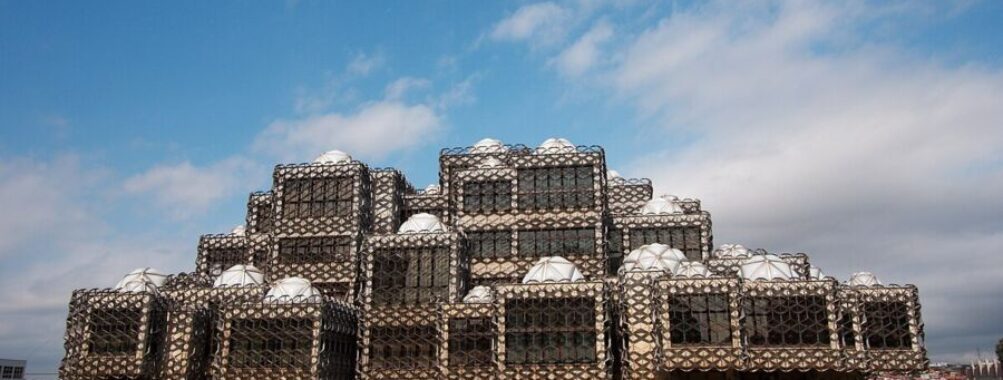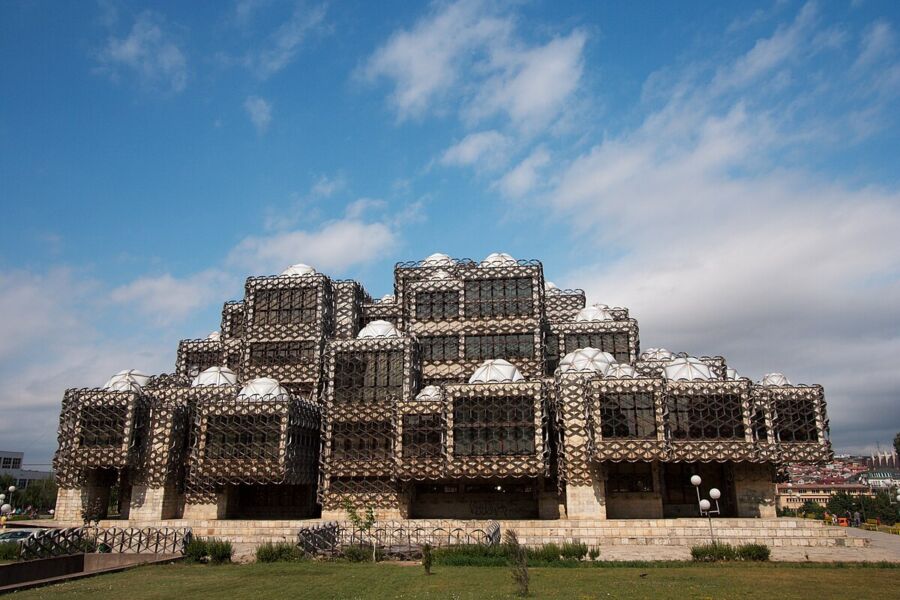
The National University Library of Kosovo
Table of Contents
History and Significance

The National Library of Kosovo was inaugurated in 1982, with its unique design being the brainchild of Croatian architect Andrija Mutnjaković. The building’s architecture is instantly recognizable, often described as a mix of Byzantine and Ottoman influences. Its 99 domes, built to resemble men’s hats of the national Albanian traditional dress, give the library a distinctive and unforgettable silhouette. The structure symbolizes the region’s complex history, intertwining elements from different cultural and historical periods. Despite critiques over its appearance, often labeled as one of the “ugliest buildings” in the world, the library’s design holds a profound symbolic significance for the people of Kosovo.
Furthermore, the library is pivotal in preserving Kosovo’s intellectual heritage. It has weathered the storms of political upheavals, including the Kosovo War, and continues to function as a reservoir of knowledge and history. Many sections of the library house an extensive collection of historical books and rare manuscripts that document the rich and diverse past of the Balkan region. This knowledge repository serves as an educational resource and a memorial to Kosovo’s resilience and cultural perseverance.
Main Attractions and Activities
A visit to the National Library of Kosovo offers more than just books. The library’s interior is elegantly designed, featuring vast reading rooms where visitors can immerse themselves in literature. The amphitheater within the library is used for various cultural and academic events, enhancing the building’s role as a center of intellectual activity. It is not uncommon to find lectures, seminars, and art exhibitions taking place here, making it a vibrant hub for scholars and artists alike. The library also houses special collections, including rare Albanian and Serbian texts, making it a treasure trove for historians and researchers.
Moreover, the library often collaborates with international organizations to host exhibitions and cultural events. Notably, during Manifesta 14 Prishtina, the library became a focal point for artistic expression and dialogue. These activities transform the library into a dynamic space beyond just being a repository of books. Visitors can engage with the region’s cultural and intellectual life more effectively and meaningfully. The architectural tours offered in the library also allow guests to learn about the unique design elements, including the aluminum and marble structures and the symbolic domes designed to resemble men’s hats.
Visitor Experience
The building’s architectural uniqueness often strikes visitors to the National Library of Kosovo. The initial impression might be perplexed due to its unconventional design, but upon entering, the library reveals a serene and scholarly atmosphere. The reading rooms are spacious, with natural light filtering through the aluminum lattices. These areas provide a quiet refuge for students and researchers. The interior design is both functional and aesthetically pleasing, with touches of marble and wood that add to the ambiance. Aside from the reading rooms, visitors can explore numerous sections dedicated to various fields of study, ranging from science and technology to literature and history.
Furthermore, the friendly and knowledgeable staff enhances the overall visitor experience. They offer guided tours that delve into the library’s history and significance, explaining the thought process behind its architectural design by Andrija Mutnjaković. These tours also highlight how the library has been a sanctuary for knowledge even during tumultuous times like the Kosovo War. Accessibility is also a key feature, with ramps and elevators available for those with mobility issues, ensuring everyone can enjoy the library’s resources without hindrance.
Tips for Visitors
To make the most of your visit to the National Library of Kosovo, it’s advisable to plan. Due to its popularity, especially among students and researchers, the library can get quite busy. Visiting during weekdays in the early hours can offer a more tranquil experience. Check the library’s schedule for any events or exhibitions that might be taking place during your visit. Engaging with these events can provide deeper insights into the local culture and intellectual scene. Taking one of the guided architectural tours available is immensely helpful in understanding the design ethos behind this unique structure.
Additionally, visitors should be mindful of the library’s rules and regulations. Silence is expected in most areas to maintain a conducive environment for reading and studying. Photography might be restricted in certain sections, so it’s best to inquire with the staff beforehand. If you plan a longer stay, use the library’s facilities, such as the cafeteria, to refresh yourself without leaving the premises. Finally, don’t forget to explore the nearby attractions in Prishtina, as the library is conveniently located close to several other landmarks, offering a comprehensive cultural experience.
Accessibility and Facilities
The National Library of Kosovo is committed to being accessible to all visitors. The building has ramps and elevators to accommodate individuals with mobility issues, ensuring that everyone can explore and benefit from the library’s extensive resources regardless of physical ability. The reading rooms are designed to be user-friendly, with ergonomic seating and ample lighting, providing a comfortable environment for extended periods of study or reading. Accessible restrooms are also available on each floor, ensuring convenience for all visitors.
Moreover, the library boasts several modern facilities to enhance the visitor experience. High-speed internet access is available throughout the building, allowing for seamless online research. Computer workstations are available for public use, making it easy for visitors to access digital resources. The library also features a cafeteria where visitors can take a break and enjoy a snack or beverage. For those looking to conduct more in-depth research, private study rooms are available to reserve. These facilities collectively ensure that the National Library of Kosovo remains a state-of-the-art institution catering to the diverse needs of its patrons.
Unique Features
One of the National Library of Kosovo’s most unique features is its architectural design. Croatian architect Andrija Mutnjaković combined Byzantine and Ottoman influences, resulting in a visually striking building unlike any other. The 99 domes on the roof are particularly notable, each designed to resemble traditional Albanian men’s hats. This distinctive design element makes the library easily recognizable and a subject of much intrigue and discussion. Using materials such as aluminum and marble within the interior adds to the library’s modern yet culturally resonant aesthetic.
The library’s collection of rare and historical books also sets it apart from other public libraries. Scholars and historians can access ancient manuscripts and texts that provide invaluable insights into the region’s past. The significance of this collection extends beyond Kosovo, attracting researchers from around the world. The library also stands out for its role during the Kosovo War, serving as a refuge for many people. This historical significance and its architectural uniqueness make the National Library of Kosovo a must-visit for anyone interested in learning about the region’s rich cultural tapestry.
Overall Impressions
The National Library of Kosovo leaves an indelible mark on its visitors. Its distinctive architecture and rich history offer a compelling narrative of cultural resilience and intellectual pursuit. Walking through its halls, one can’t help but feel a deep sense of respect for the efforts made to preserve Kosovo’s heritage. The library stands as a testament to the enduring power of knowledge and education, serving as a beacon of hope and enlightenment in the heart of Prishtina. Whether you’re a student, a researcher, or simply a curious traveler, the library offers a unique experience that is both educational and inspiring.
Moreover, the library’s welcoming atmosphere and comprehensive facilities make it accessible and enjoyable. The blend of modern amenities with historical treasures creates a space where the past and future coexist harmoniously. The National Library of Kosovo is more than just a building; it’s a living, breathing entity that reflects the region’s soul. Its role as a cultural and intellectual hub cannot be overstated, making it one of the most important landmarks in Prishtina. The overall impression is awe and admiration, a place where the spirit of knowledge is alive and thriving.
Pros and Cons
The National Library of Kosovo has many strong points that make it a beloved institution. One of the biggest pros is its extensive collection of rare and historical texts, which are invaluable for researchers and scholars. The architectural design, while controversial, is undoubtedly unique and adds to the library’s charm. The modern facilities, including high-speed internet and ergonomic seating, enhance the visitor experience. Additionally, the library’s commitment to accessibility ensures that everyone can benefit from its resources. The various cultural and academic events hosted at the library also provide an enriching experience for visitors.
However, there are some cons to consider. The library’s design, described by some as one of the “ugliest buildings” in the world, can be off-putting to those with traditional aesthetic preferences. During peak times, the library can get crowded, making it difficult to find a quiet spot for reading or studying. The rules regarding silence and photography can also be restrictive for some visitors. Despite these minor drawbacks, the National Library of Kosovo remains a significant cultural and educational landmark, offering far more pros than cons. It’s a place that challenges perceptions and fosters a deeper appreciation for the region’s rich intellectual heritage.
Location
Places to Stay Near The National University Library of Kosovo
Find and Book a Tour
Explore More Travel Guides
No reviews found! Be the first to review!